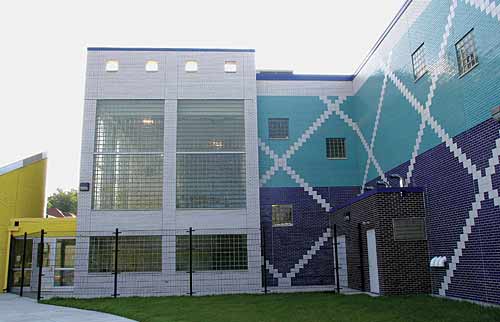 |
Patton Park. Detroit Recreation Center, Detroit, MI designed by Ralph Calder & Associates, Architects-now merged with David Milling Architects.
Courtesy of Pittsburgh Corning Glass Block |
|
Since 1949, the Detroit Recreation Department's (DRD) Patton Park has served a neighborhood located between the industrial and commercial centers of southwest Detroit. Since the 1970s, the brick walls of the recreation center had become a canvas to express a diversity of cultural interests. These activities led the area's residents, who used the facility on a regular basis, to raise safety concerns. Originally, the enclosure walls of Patton Park's indoor/outdoor pool featured a pair of elegant glass doors that opened onto an outdoor sundeck. Over the years, panels of plywood, substituted for vandalized glass, soon became the only barrier separating the pool from the weather. Near-constant abuse of the facility, caused by graffiti and vandalism, contributed to significant deterioration of the building. Eventually, the damage was so great that the renovation of the park, including the soccer/baseball fields, gymnasium and swimming pool, became mandatory to safely keep the facilities open for the community's use.
Plans for the new Patton Park were finalized in 2004 and Ralph Calder & Associates, Architects-now merged with David Milling Architects, Ann Arbor, MI-was approved to complete the renovation plans. With the building's foundation intact, the reconstruction effort included a focus on the replacement of the windows around the gymnasium and pool area. Aluminum windows and plastic glazing are typical choices in window replacement, however, Ralph Calder & Associates decided that, in response to past concerns expressed by the local community, the choice warranted a more secure and durable building product. The firm turned to solid glass block products, for the solution.
After testing the block using gunfire and various other destructive measures, DRD officials approved the block according to the Urban Proof Concept Design specifications, a standard unique to the city of Detroit, which is used to determine the viability of products used in construction projects.
The scope of work at Patton Park included a 36,000-square-foot renovation and a 9,000-square-foot addition. In total, 3,500 square feet of solid glass block was specified throughout the building to replace more than just the exterior windows, as originally planned. The new two-and-a-half story atrium entrance, which features more than 1,200 square feet of glass block, is flooded with natural light during the day and glows incandescently across the park by night.
Above the street level entrance, 10-foot square panels brighten the exercise and dance spaces. Thirty-six glass block windows measuring 40 inches by 40 inches were incorporated into the design of the center's perimeter brick walls. Punched openings admit light into the gymnasium, meeting room, senior citizen area, art room, weight room and administrative offices.
After two years and a $10 million makeover, the DRD's Patton Park reopened its doors in May of 2006. It did not take long for the hustle and bustle of the city's life to return to the gym floor. "We are very pleased with the results," says Dennis Anderson, AIA, now with David Milling Architects. "People who wanted to tear the building down and who objected to the remodeling couldn't believe their eyes when it was completed."










